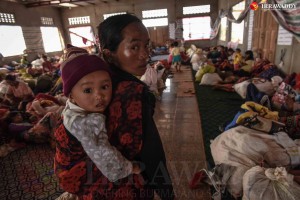Divide Rule Produces Dividends for the Burma Army
By Burma Partnership • February 24, 2016
The decades-long tactic of divide-and-rule used by successive regimes in Burma when dealing with ethnic groups produced dividends in February 2016, as ongoing armed clashes between troops from the ethnic Ta’ang, Ta’ang National Liberation Army (TNLA) and ethnic Shan, Shan State Army – South (SSA-S), in northern Shan State has displaced up to 5,000 civilians in just one week while thousands more have been trapped in Kyaukme Township, waiting to move to a safe location. In tandem with these clashes the Burma Army has also launched fresh offensives against the TNLA in northern Shan State, leaving them exposed on two fronts.
The latest offensives by the Burma Army began on 11 February, using helicopters and a fighter jet to launch airstrikes in Kutkai Township. Meanwhile, sporadic clashes between the SSA-S and the TNLA intensified between 12-18 February in Kyaukme Township, with local communities placing blame on both sides amid allegations of human rights abuses. A proposal was tabled in Parliament by a local MP and passed by the Lower House to end the fighting. Yet in the parliamentary session, military MPs, who are constitutionally assigned 25% of seats, described the TNLA as “rebels” – a term that ethnic armed organizations (EAOs) such as the TNLA reject – and stated that the only way to end the conflict is for the TNLA to “completely relinquish all its weapons.” Significantly, no such calls were made regarding the SSA-S.
The SSA-S was a signatory to the much disputed nationwide ceasefire agreement (NCA) in October 2015 while the TNLA was one of the groups that the Government excluded from the process. The SSA-S initially hesitated to sign the NCA, before eventually acceding a week before the signing ceremony. Since the NCA was signed, Burma Army offensives against the TNLA have increased in ferocity, while allegations have emerged of collaboration between SSA-S and Burma Army troops in these offensives. In the recent clashes, a representative from another EAO, the Shan State Progressive Party (SSPP), who visited the conflict area, stated that the Burma Army were positioned nearby but did not join. Instead, “they just watch.”
It is clear who the real beneficiary is of this fighting, and that is the Burma Army. It is a divide and rule policy of creating tensions and ultimately fighting between different EAOs. A united front by EAOs is a prospect that the Burma Army has always tried to prevent from happening, offering incentives and deals with certain EAOs while excluding others who are simultaneously subjected to pressure from military attacks. History speaks of this. For example, during the 1990s the Karen National Union on the eastern border faced fierce attacks while the Burma Army was making a ceasefire deal with Kachin Independence Army in the north – a tactic that that divided the ethnic alliance of that time. This was also evident this week as the Government’s main peace negotiator, Aung Min, travelled to Chiang Mai to meet with members of the EAO alliance, the United Nationalities Federal Council (UNFC). Yet he did not want to meet the UNFC as a bloc, instead intending to meet member groups separately, which was rejected by the UNFC, eventually resulting in Aung Min relenting on his original plan. Khu Oo Reh, UNFC General Secretary stated, “We will only meet under the UNFC title. And we are against the divide-and-meet policy that the [current] government is using.”
As usual, it is the communities that are suffering, sheltering in nearby monasteries as fear spreads through local villages. Inter-ethnic tensions and distrust now prevail in communities that have experienced this conflict.
The Burma Army is a highly effective and politically skilful institution that is playing ethnic groups against each other, and has been doing so for decades. The signing of the NCA, which excluded certain EAOs, has proved not only to be redundant in bringing the peace process forward, but is a divisive tool from which this inter-ethnic violence has stemmed from. This only underlines the necessity of the initiation of a new peace process based on good-faith, not Machiavellian cunning. It also underlines how the international community and in particular the peace donors, must learn from the lessons of history on how the Burma Army has dealt with EAOs through divide-and-rule, a tactic that has not changed. The EAOs themselves must also not succumb to the false promises and divide-and-rule manipulation of the Burma Army, and remain on a clear path towards their aspirations of ethnic equality, self-determination, and federalism. Unless the Burma Army commits itself to a process of solving the root cause of problems that create conflict, namely denying the right to equality and self-determination of ethnic people, achieving a genuine and sustainable peace will still be distant and thus ethnic communities will continue to suffer from the machinations and abuse that are perpetuated by Burma Army.
Tags: Burma Partnership, Ethnic Armed Organizations, Nationwide Ceasefire Agreement, Restoration Council of Shan State, Shan State, Shan State Army, Ta'ang National Liberation Army, United Nationalities Federal CouncilThis post is in: Blog
Related PostsBurma Partnership Celebrates Continuing Regional Solidarity for Burma and Embraces the Work Ahead for Progressive Voice
Burma Army Displays Blatant Disregard for 21st Century Panglong Peace Process
Ann Din Coal Power Plant: Local Movement and Action to Preserve and Protect Natural Resources and Land: Mon IDP Report Case Study #4
Latest Human Rights Abuse Case Demonstrates Urgent Need to Reform the Myanmar National Human Rights Commission
Human Rights Far From Guaranteed as US Sanctions on Burma Are Removed









 All posts
All posts